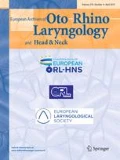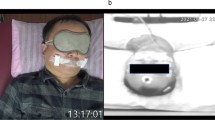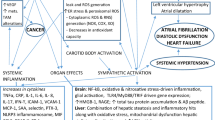Abstract
To develop and validate an objective method for calculating the annoyance caused by snoring sounds. 53 subjects assessed 50 different snoring and breath sounds on a visual analog scale for level of annoyance. A linear regression analysis was used to correlate these subjective assessments with objectively calculated psychoacoustic parameters (loudness, roughness, sharpness, and fluctuation strength, calculating the maximum, mean, and 5th percentile in each case). The quality of the resulting formula was checked, and additional validation was performed using subjective assessments of 60 new snoring and breath sounds by 52 new subjects. Receiver operating characteristic (ROC) analysis was used to scale the annoyance ranges obtained with the formula. A score consisting of the 5th percentile of loudness and the mean of roughness was developed. The formula displays high goodness of fit (R 2 = 0.91) and quality. In the validation phase, a highly significant correlation (r s = 0.95; p < 0.01) was obtained between the scores calculated with the formula and the subjective assessments. ROC analysis was able to define the annoyance ranges with a discriminatory power between 52 and 73 % (optimum sensitivity/specificity). The subjective assessments made by the participants were distinctly scaled and were reflected in a psychophysical algorithm. In the setting of polygraphy and polysomnography, this means that a reliable annoyance score that is not dependent on the bed partner can be obtained to establish the indication for anti-snoring treatments and to review their utility.



Similar content being viewed by others
References
Stuck BA, Dreher A, Heiser C, Herzog M, Kühnel T, Maurer JT, Pistner H, Sitter H, Steffen A, Verse T (2015) Diagnosis and treatment of snoring in adults-S2k Guideline of the German Society of Otorhinolaryngology, Head and Neck Surgery. Sleep Breath 19:135–148
Pevernagie D, Aarts RM, de Meyer M (2010) The acoustics of snoring. Sleep Med Rev 14:131–144
Hoffstein V (1996) Snoring. Chest 109:201–222
Beck R, Odeh M, Oliven A, Gavriely N (1995) The acoustic properties of snores. Eur Respir J 8:2120–2128
Ulfberg J, Carter N, Talbäck M, Edling C (2000) Adverse health effects among women living with heavy snorers. Health Care Women Int 21:81–90
Blumen MB, Quera Salva MA, Vaugier I, Leroux K, d’Ortho M, Barbot F, Chabolle F, Lofaso F (2012) Is snoring intensity responsible for the sleep partner’s poor quality of sleep? Sleep Breath 16:903–907
McArdle N, Kingshott R, Engleman HM, Mackay TW, Douglas NJ (2001) Partners of patients with sleep apnoea/hypopnoea syndrome: effect of CPAP treatment on sleep quality and quality of life. Thorax 56:513–518
Troxel WM, Buysse DJ, Hall M, Matthews KA (2009) Marital happiness and sleep disturbances in a multi-ethnic sample of middle-aged women. Behav Sleep Med 7:2–19
Virkkula P, Bachour A, Hytönen M, Malmberg H, Salmi T, Maasilta P (2005) Patient- and bed partner-reported symptoms, smoking, and nasal resistance in sleep-disordered breathing. Chest 128:2176–2182
Laszlo HE, McRobie ES, Stansfeld SA, Hansell AL (2012) Annoyance and other reaction measures to changes in noise exposure—a review. Sci Total Environ 435–436:551–562
van Kempen E, van Kamp I, Nilsson M, Lammers J, Emmen H, Clark C, Stansfeld S (2010) The role of annoyance in the relation between transportation noise and children’s health and cognition. J Acoust Soc Am 128:2817–2828
Basner M, Babisch W, Davis A, Brink M, Clark C, Janssen S, Stansfeld S (2014) Auditory and non-auditory effects of noise on health. Lancet 383:1325–1332
Lekaviciute J, Argalasova-Sobotova L (2013) Environmental noise and annoyance in adults: research in Central, Eastern and South-Eastern Europe and Newly Independent States. Noise Health 15:42–54
Kasess CH, Noll A, Majdak P, Waubke H (2013) Effect of train type on annoyance and acoustic features of the rolling noise. J Acoust Soc Am 134:1071–1081
Münzel T, Gori T, Babisch W, Basner M (2014) Cardiovascular effects of environmental noise exposure. Eur Heart J 35:829–836
Fastl H, Zwicker E (2007) Psychoacoustics: facts and models. Springer, Berlin
Durbin J, Watson GS (1951) Testing for serial correlation in least squares regression. Biometrika 38:159–177
Hoffstein V, Mateika S, Anderson D (1994) Snoring: is it in the ear of the beholder? Sleep 17:522–526
Hoffstein V (2007) Review of oral appliances for treatment of sleep-disordered breathing. Sleep Breath 11:1–22
Wiggins CL, Schmidt-Nowara WW, Coultas DB, Samet JM (1990) Comparison of self- and spouse reports of snoring and other symptoms associated with sleep apnea syndrome. Sleep 13:245–252
Counter P, Wilson JA (2004) The management of simple snoring. Sleep Med Rev 8:433–441
Miljeteig H, Mateika S, Haight JS, Cole P, Hoffstein V (1994) Subjective and objective assessment of uvulopalatopharyngoplasty for treatment of snoring and obstructive sleep apnea. Am J Respir Crit Care Med 150:1286–1290
Sériès F, Marc I, Atton L (1993) Comparison of snoring measured at home and during polysomnographic studies. Chest 103:1769–1773
Dalmasso F, Prota R (1996) Snoring: analysis, measurement, clinical implications and applications. Eur Respir J 9:146–159
Rohrmeier C, Fischer R, Merz A, Ettl T, Herzog M, Kuehnel TS (2015) Are subjective assessments of snoring sounds reliable? Eur Arch Otorhinolaryngol 272:233–240
Ellermeier W, Mader M, Daniel P (2004) Scaling the unpleasantness of sounds according to the BTL model: ratio-scale representation and psychoacoustical analysis. Acta Acust United Acust 90:101–107
Rohrmeier C, Herzog M, Haubner F, Kuehnel TS (2012) The annoyance of snoring and psychoacoustic parameters: a step towards an objective measurement. Eur Arch Otorhinolaryngol 269:1537–1543
Herzog M, Bremert T, Herzog B, Hosemann W, Kaftan H, Müller A (2011) Analysis of snoring sound by psychoacoustic parameters. Eur Arch Otorhinolaryngol 268:1386–1389
Herzog M, Kellner P, Plößl S, Glien A, Rohrmeier C, Kühnel T, Plontke S, Herzog B (2015) Drug-induced sleep endoscopy and simulated snoring in patients with sleep-disordered breathing: agreement of anatomic changes in the upper airway. Eur Arch Otorhinolaryngol 272:2541–2550
Ng AK, Koh TS, Baey E, Puvanendran K (2009) Role of upper airway dimensions in snore production: acoustical and perceptual findings. Ann Biomed Eng 37:1807–1817
Caffier PP, Berl JC, Muggli A, Reinhardt A, Jakob A, Möser M, Fietze I, Scherer H, Hölzl M (2007) Snoring noise pollution—the need for objective quantification of annoyance, regulatory guidelines and mandatory therapy for snoring. Physiol Meas 28:25–40
Wilson K, Stoohs RA, Mulrooney TF, Johnson LJ, Guilleminault C, Huang Z (1999) The snoring spectrum: acoustic assessment of snoring sound intensity in 1,139 individuals undergoing polysomnography. Chest 115:762–770
Ising H, Kruppa B (2004) Health effects caused by noise: evidence in the literature from the past 25 years. Noise Health 6:5–13
Menzel D, Fastl H, Graf R, Hellbrück J (2008) Influence of vehicle color on loudness judgments. J Acoust Soc Am 123:2477–2479
Ellermeier W, Eigenstetter M, Zimmer K (2001) Psychoacoustic correlates of individual noise sensitivity. J Acoust Soc Am 109:1464–1473
Kühnel T, Glas S, Herzog M, Gassner H, Rohrmeier C (2014) Psychosocial burden caused by snoring. Somnologie 18:80–86
Hoeger R, Schreckenberg D, Felscher-Suhr U, Griefahn B (2002) Night-time noise annoyance: state of the art. Noise Health 4:19–25
Rohrmeier C, Herzog M, Ettl T, Kuehnel TS (2014) Distinguishing snoring sounds from breath sounds: a straightforward matter? Sleep Breath 18:169–176
Herzog M, Kühnel T, Bremert T, Herzog B, Hosemann W, Kaftan H (2009) The impact of the microphone position on the frequency analysis of snoring sounds. Eur Arch Otorhinolaryngol 266:1315–1322
Abeyratne UR, Wakwella AS, Hukins C (2005) Pitch jump probability measures for the analysis of snoring sounds in apnea. Physiol Meas 26:779–798
Azarbarzin A, Moussavi Z (2013) Intra-subject variability of snoring sounds in relation to body position, sleep stage, and blood oxygen level. Med Biol Eng Comput 51:429–439
Lee BW, Hill PD, Osborne J, Osman E (1999) A simple audio data logger for objective assessment of snoring in the home. Physiol Meas 20:119–127
Acknowledgments
We are grateful to Eric Siegel for programming the software for sound sequence playback and to the many subjects who participated in the study.
Author information
Authors and Affiliations
Corresponding author
Ethics declarations
Disclosure statement
There are no institutional or corporate affiliations of the authors and there are no funding sources which supported the work.
Ethical approval
All procedures performed in studies involving human participants were in accordance with the ethical standards of the institutional and/or national research committee and with the 1964 Helsinki declaration and its later amendments or comparable ethical standards.
Informed consent
Informed consent was obtained from all individual participants included in the study.
Rights and permissions
About this article
Cite this article
Fischer, R., Kuehnel, T.S., Merz, AK. et al. Calculating annoyance: an option to proof efficacy in ENT treatment of snoring?. Eur Arch Otorhinolaryngol 273, 4607–4613 (2016). https://doi.org/10.1007/s00405-016-4160-9
Received:
Accepted:
Published:
Issue Date:
DOI: https://doi.org/10.1007/s00405-016-4160-9




